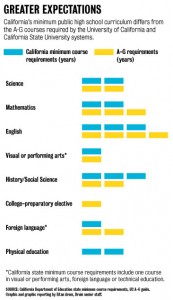Much of the campus conversation around increasing diversity focuses on an “education pipeline” that should, in theory, take high school students from across California and funnel them through the state’s various higher education systems.
New data showing that 6 in 10 public high school students are not eligible for enrollment in the University of California or the California State University system demonstrates that if that pipeline ever existed, it is currently broken down.
Numbers released by the California Department of Education indicate that only 4 in 10 public high school students in 2012 completed the A-G requirements, a set of 15 courses that must be fulfilled with a minimum passing grade of a C in order to apply to UC and CSU schools.
California high school districts need to prioritize and expedite the process of making A-G courses required parts of their graduation curricula. In turn, the UC and CSU should be using their clout to advocate for a level playing field for high school students seeking access to higher education.
Finally, for their part, UCLA students can champion this goal by scaling up outreach programs that encourage local high school students to complete the A-G requirements, at least until those standards are implemented statewide.
To be sure, the A-G requirements are necessary to provide broad academic preparation in an array of subjects. However, the way they are currently being practiced, without obligating California public high schools to enforce the requirements as part of their graduation curriculum, merely serves as a way to restrict access to higher education for certain groups, predominantly minority or underserved communities.
A report from the Public Policy Institute of California indicated that the groups most likely to fulfill the requirements to apply for UC and CSU schools are from wealthier families, and are white or Asian. The report noted that “differences in eligibility rates are especially large at UC, with rates for Asians over four times higher than those for Latinos and African Americans.”
Functionally, California has a patchwork of educational requirements for high schools, a system that inherently disadvantages students who come from districts that haven’t taken the initiative to incorporate A-G standards into their graduation curricula.
Even among high schools that offer A-G courses, some require students to opt into the A-G course track, which many aren’t aware of until it’s too late. Some schools that offer A-G requirement courses allow a D to serve as a passing grade, which would still disqualify the student from being eligible to apply to the UC or CSU.
The reason for the eligibility gap is not generally a lack of courses that could, in theory, apply for A-G requirements.
A lot of high schools have classes that would fulfill the A-G requirements with little to no adjustment in curriculum, meaning the infrastructure for A-G courses to become a high school graduation requirement standard already exists in many cases.
In the Los Angeles Unified School District, the UC has been instrumental in helping schools implement A-G requirements, said UC spokeswoman Shelly Meron. But LAUSD’s decision to require A-G courses was independent of the University’s influence.
However, for a university that prides itself on diversity but suffers from a lack thereof, inserting itself in the conversation about requiring A-G courses in high schools statewide should be an imperative.
Having identified a roadblock to higher education access for underrepresented communities, it is the University’s responsibility to work to level it.
Some attribute the lack of diversity in the UC to Proposition 209, which outlawed the use of race-conscious admissions in California public universities. But even if the University were allowed to consider race when admitting students, it could not tap high schoolers who haven’t completed the prerequisite courses.
Increasing eligibility rates won’t be a fix-all solution for the looming institutional problems that exist within the California public education system. But implementing and requiring A-G courses statewide at least means that all students will stand a fair chance at higher education.
Creating eligibility requirements without a framework for their implementation in curriculum is only doing half the job. Despite the UC’s willingness to help schools transition to A-G courses once the district makes the initial decision to convert curricula, not pushing schools to make these courses graduation requirements allows the UC and CSU to put off responsibility until too late in the game.
The UC and CSU, both institutions built on the fundamental pillar of educational opportunity, are taking a backseat attitude to promoting this opportunity across the state.
Send general comments to opinion@media.ucla.edu or tweet us @DBOpinion.

